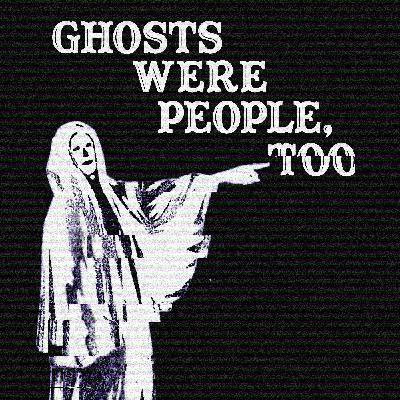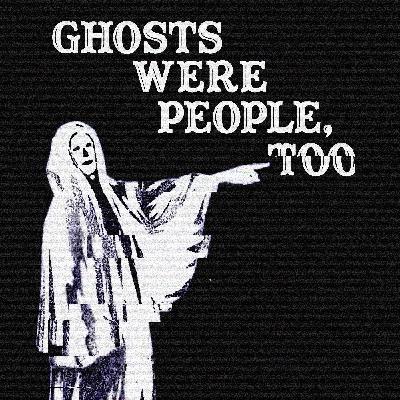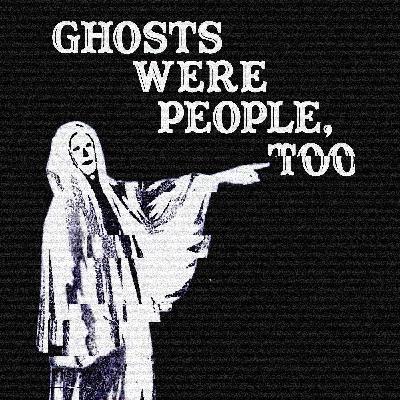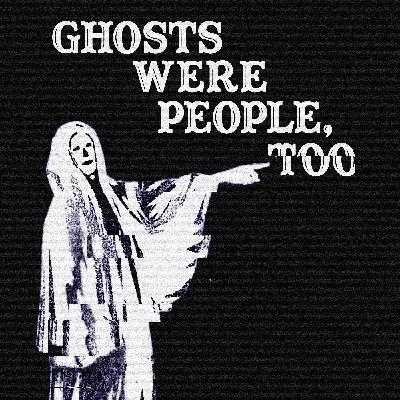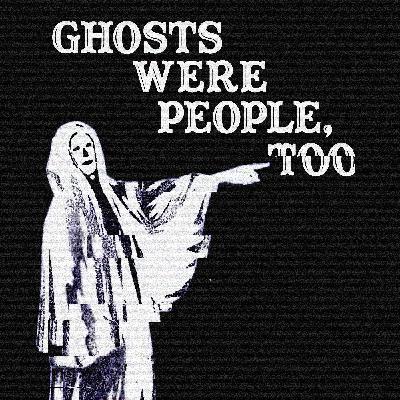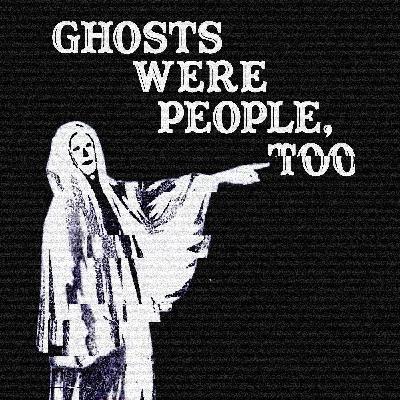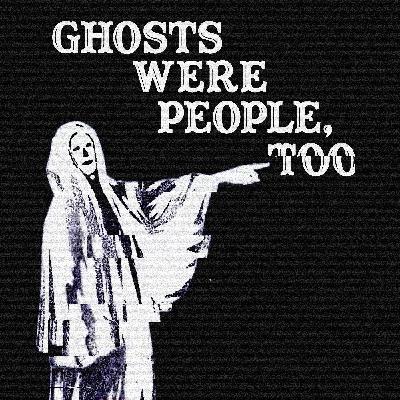Discover Ghosts Were People Too
Ghosts Were People Too

Ghosts Were People Too
Author: Annabelle Bonebrake and Quest Zeidler
Subscribed: 3Played: 26Subscribe
Share
© All rights reserved.
Description
Where do ghosts dwell? It seems just about everywhere: television, film, photography, theater, video games, folk songs, and even your family vacations. Oh the humanties! Join your hosts Quest and Annabelle on cultural ghost tour in Ghosts Were People Too, a podcast that investigates ghosts through the lens of the arts & humanities.
18 Episodes
Reverse
In this Halloween special, Quest and Annabelle talk about the poetics, play, and "dangers" of the Ouija board.Make contact:@ghostswerepeopletoo (tumblr/instagram)gwp2pod@gmail.comBibliography:“‘The Medium is the Message in the Spacious Present’: Channeling, Television, and the New Age” by Hugh Urban, in Handbook of Spiritualism and Channeling, ed. Cathy Gutierrez“Parlor Games: Play and Social Life in the Haunted House” in Supernatural Entertainments: Victorian Spiritualism and the Rise of Modern Media Culture by Simone Natale“Wars and Ouija: Spiritualism in the Twentieth Century” in Calling the Spirits by Lisa Morton“An Aesthetic History of the Ouija Board’ by Jesse Ryan Erickson, in Printing History“James Merrill, Sylvia Plath, and the Poetics of Ouija” by Helen Sword in American Literature, vol. 66, no. 3, 1994 https://doi.org/10.2307/2927604
In this, the first of our series on Disneyland's Haunted Mansion, Annabelle and Quest climb into the attic to uncover its ghostly brides, gothic backstory, and Disney’s spooky-funny balance. From the Beating Heart Bride to Constance Hatchaway, we ask what this haunted attic reveals about our fears, our histories, and our love of ghosts.Make contact:@ghostswerepeopletoo (tumblr/instagram)gwp2pod@gmail.comBibliography:Davison, Carol Margaret. “Southern Gothic: Haunted Houses.” The Palgrave Handbook of the Southern Gothic, edited by Susan Castillo Street and Charles L. Crow, Palgrave Macmillan, 2016, pp. 57–74Donovan-Condron, Kellie. “Twisted Sisters: The Monstrous Women of Southern Gothic.” The Palgrave Handbook of the Southern Gothic, edited by Susan Castillo Street and Charles L. Crow, Palgrave Macmillan, 2016, pp. 369–83.Giles, David. “The Thousandth Happy Haunt: Legends of Burial and Haunting at Disneyland’s Haunted Mansion.” Western Folklore, vol. 74, no. 3/4, 2015, pp. 297–316.Martens, Todd. “First Look: Disneyland’s Original Haunted Mansion Returns with a Heartbreaking New Scene.” Los Angeles Times, 17 Jan. 2025.Steiner, Michael. “Frontierland as Tomorrowland: Walt Disney and the Architectural Packaging of the Mythic West.” Montana: The Magazine of Western History, vol. 48, no. 1, 1998, pp. 2–17.Surrell, Jason. The Haunted Mansion: Imagineering a Disney Classic. Disney Editions, 2009.Tromp, Marlene. “‘Throwing the Wedding-Shoe’: Foundational Violence, Unhappy Couples, and Murderous Women.” Victorian Review, vol. 20, no. 2, 1994, pp. 36–54.Truffin, Sherry R. “New Orleans as Gothic Capital.” The Palgrave Handbook of the Southern Gothic, edited by Susan Castillo Street and Charles L. Crow, Palgrave Macmillan, 2016, pp. 151–65.Weinstock, Jeffrey Andrew. “Hidden Histories: The Many Ghosts of Disneyland’s Haunted Mansion.” Disney Gothic: Dark Shadows in the House of Mouse. Edinburgh University Press, 2019, pp. 29–46.
Dreams, collective trauma, stranger danger, groomer panic, queer death drive/queer evil, and media horror - it's all lurking below the surface in A Nightmare on Elm Street (1984). Make contact:@ghostswerepeopletoo (tumblr/instagram)gwp2pod@gmail.comBibliographyEdelman, Lee. No Future: Queer Theory and the Death Drive. Duke University Press, 2004.Kendrick, James. “Razors in the Dreamscape: Revisiting A Nightmare on Elm Street and the Slasher Film.” Cinema Journal, vol. 50, no. 1, Fall 2010, pp. 60-78.Lieberman, Tucker. “The Trail of His Flames.” The American Reader, vol. 5, no. 1, Fall 2019.Schildcrout, Jordan. Murder Most Queer: The Homicidal Homosexual in the American Theater. University of Michigan Press, 2014.Thomsen, Morten Feldtfos. “‘Evil Never Dies, Right?’ Monstrous Mediation in the A Nightmare on Elm Street Film Series.” Journal of Aesthetics & Culture, vol. 16, no. 1, 2024.
Part two of our Haunting of Hill House special!In this episode we discuss Hill House as a character, the origins of the Victorian haunted house trope, and how... every room becomes a mouth!Make contact:@ghostswerepeopletoo (tumblr/instagram)gwp2pod@gmail.com
For our very special 13th episode, we present part one of a two-part series on the novel The Haunting of Hill House by Shirley Jackson and its film adaptation The Haunting (1963). In part 1, we talk about the movie vs. the book, approaches to paranormal research, the Cult of True Womanhood, monstrous family systems, and Lesbians!Make contact:@ghostswerepeopletoo (tumblr/instagram)gwp2pod@gmail.comBibliography“Walking Alone Together: Family Monsters in The Haunting of Hill House” by Richard PascalInterview: Laurence Jackson Hyman on his mother Shirley: ‘Her work is so relevant now…’ by Rachel Cooke. The Guardian.“Opening Up” in Men, Women, and Chain Saws by Carol CloverThe Haunting of Hill House, Introduction by Laura Miller“Walking Alone Together: Family Monsters in The Haunting of Hill House” by Richard Pascal in Studies in the NovelQueer for Fear, Episode 4Welter, Barbara. “The Cult of True Womanhood: 1820-1860.” American Quarterly, vol. 18, no. 2, 1966, pp. 151–74. JSTOR, https://doi.org/10.2307/2711179. Accessed 31 Aug. 2024.
Ballads and broadsides, sailors and skeletons, sisters and sampling, and... have you seen the ghost of John? Join us to talk about ghosts in folk music. We touch on some common themes and formats as well as academic approaches to analyzing and archiving folk tunes/lyrics. Come for the intertextuality, sociofunctionalism, politics, and anthropology-- stay for the boos.Want to sing along? Make contact:Make contact:@ghostswerepeopletoogwp2pod@gmail.comBibliography"Shall I Sing You a Ghost Story: The Nature and Purpose of Ghost Songs in Maritime Communities of Northern New England and Atlantic Canada" by Richard A. Blake (2019). All Graduate Plan B and other Reports. “Ghosts of Voices: Hauntology and Folk Music” by Eamon Byers. Folk Horror Revival: Harvest Hymns. Volume I- Twisted Roots, Volume 1"Folk Songs as Socio-Historical Documents" by John Greenway. Western Folklore, vol. 19, no. 1, 1960, pp. 1–9. JSTOR.“The English, Scottish, and American Versions of the ‘Twa Sisters’” by Archer Taylor, in The Journal of American Folklore“‘The Twa Sisters’—Going Which Way?” by Harbison Parker, in The Journal of American Folklore“Magical Corpses: Ballads, Intertextuality, and the Discovery of Murder” by David Atkinson, in Journal of Folklore Research“Comparativism and the Functional Contexts of Myths and Rituals”, from Mythography by William Doty“Maieutic, Creative Myth: Conveying Values and Systems of Interpreting Reality (Definition, part 2)”, from Mythography by William Doty"'Have You Seen The Ghost Of John” is a kids’ song that actually chills'" by Mariah Eakin. AV Club."“Ghost of John”: Appalachia’s Most Ghoulish Lullaby" by Musette. Medium. SongsAlan Mills (The Ghostly Sailors)-Accordion https://youtu.be/CpysXQtf1Y0?si=tbeb8EzPfeSZUpeJHoulihan (The Ghostly Sailors)-Acapella https://youtu.be/k7wbShaiZGg?si=83P6fIghjOiH-_qhHave You Seen the Ghost of John (Children Singing) https://youtu.be/6F9mcvX9pXE?si=zoSRCe_c2IM9kCs7“Binnorie (The Twa Sisters)” as sung by Custer LaRue ://youtu.be/rLBBg4MjO6oThe Geography by Belbury Polyhttps://youtu.be/vv4tsUg7MLQ
Baltimore-based artist Angela Deane paints sheet ghosts onto found photos. You might know Deane's work from the cover of Phoebe Bridgers' Stranger in the Alps (2017) or perhaps you've seen her ghosties elsewhere in the great digital regions beyond.This is part 2! Go check out part 1 (episode 10) We dare you. Here, we talk about nostalgia theory, leisure photography, and kitsch. Enjoy!Make contact:@ghostswerepeopletoogwp2pod@gmail.comBibliographyhttps://angeladeane.com/home.htmlThe Hours Have Lost Their Clock by Grafton TannerThe Way We Never Were: American Families and the Nostalgia Trap by Stephanie CoontzScarbrough, Elizabeth. “Unimagined Beauty.” The Journal of Aesthetics and Art Criticism, vol. 72, no. 4, 2014, pp. 445–49. JSTOR, http://www.jstor.org/stable/43282368. Kitson, Jennifer, and Kevin McHugh. “Historic Enchantments – Materializing Nostalgia.” Cultural Geographies, vol. 22, no. 3, 2015, pp. 487–508. JSTOR, https://www.jstor.org/stable/26168663.Goodwin, Sarah Webster. “Domesticity and Uncanny Kitsch in ‘The Rime of the Ancient Mariner’ and Frankenstein.” Tulsa Studies in Women’s Literature, vol. 10, no. 1, 1991, pp. 93–108. JSTOR, https://doi.org/10.2307/463954. “Chapter 5: Chansonetta Stanley Emmons’s Nostalgic Views” from At the Edge of Sight: Photography and the Unseen by Shawn Michelle Smith
Baltimore-based artist Angela Deane paints sheet ghosts onto found photos. You might know Deane's work from the cover of Phoebe Bridgers' Stranger in the Alps (2017) or perhaps you've seen her ghosties elsewhere in the great digital regions beyond.In this, part one of a two-part episode, we talk briefly about nostalgia (more on that in part 2), and then dig into Deane's artist statement. What does it mean to capture a moment in time? Photography as an art form plays with notions of presence and absence. How does spirit photography manage equations of presence and absence? How does Angela Deane play with these concepts in her Ghost Paintings?Then, we revisit theories and histories regarding spirit photography (see Episodes 1 & 2 for more) to contextualize the impact of Deane's contemporary take on image doctoring.Note: Annabelle now knows how to pronounce "Prarie Schooner" thanks to a two-second Google search. Whoops. Peace and Love. Make contact:@ghostswerepeopletoogwp2pod@gmail.comBibliographyhttps://angeladeane.com/home.htmlPhotography and Spirit by John Harvey, “Chapter 3: Art”At the Edge of Sight: Photography and the Unseen by Shawn Michelle Smith, “Chapter 5: Chansonetta Stanley Emmons’s Nostalgic Views”MORGAN, JAMES. “NOSTALGIA.” Prairie Schooner, vol. 8, no. 3, 1934, pp. 153–153. JSTOR, http://www.jstor.org/stable/40622498.
Happy Halloween! It's Spooky (Mulder) Season, so we're talking about ghosts in the X-Files S4E22 "Elegy". It's not the only X-Files episode with ghosts, but it's a particularly creepy one. We hope you enjoy our discussion of haunted bowling alleys, inconvenient nosebleeds, white woman Wednesday, and pills that make you a serial killer. What are ghosts? What are frogs? Listen even though you probably won't find out. Mild content warning for discussion of femicide and ableism, specifically pertaining to people with autism.Make contact:@ghostswerepeopletoogwp2pod@gmail.comBibliographyThe Official Guide to The X-Files: I Want to Believe by Andy Meisler“Current Superstitions. I. Omens of Death” by Fanny D. Bergen, W. M. Beauchamp, and W. W. Newell, in The Journal of American Folklore“Current Superstitions. II. Omens of Death (continued)” by Fanny D. Bergen, W. M. Beauchamp, and W. W. Newell, in The Journal of American Folklore“American Attitudes to Death” by Charles O. Jackson, in Journal of American Studies“Bowling Alone: In which she is me” by Emily St. James, in Monsters of the Week: The Complete Critical Companion to The X-Files by Zack Handlen & Emily St. James
Is Ghostbusters the most American movie ever made? Your Ghost Hosts answer this and other questions you never asked in Part II of II on Ghostbusters (1984). We discuss the iconic film through multiple critical lenses including immigration, invaders, Orientalism, Spiritualism, the Occult, and Ghosthunting Capitalism.Make contact:@ghostswerepeopletoogwp2pod@gmail.comBibliography“Opening Up” in Men, Women, and Chain Saws by Carol Clover“Immigrants as aliens in the Ghostbusters films” by Zoila ClarkOrientalism by Edward SaidAnderson, Matthew N., and Collin L. Brown. ""We're Ready to Believe You!": Spiritualism and the Interpretation of Paranormal Experience in Ghostbusters (1984)." The Paranormal and Popular Culture, 2019, pp. 133-146.Podcast Episode: “How the Evangelical Machine Got Made” by The Experiment Podcast Series: The Orange Wave: A History of the Religious Right Since 1960https://www.apollo-magazine.com/rudolf-steiner-occult-modernism/https://superweirdsubstance.com/nikola-tesla/
Bustin' makes me feel... bad? What was meant to be an "easy, breezy, beautiful" 80s night became a two-part "cold hard research" episode. In part one, Quest and Annabelle give their first impressions of Ghostbusters (1984). They also unpack the "totemic nostalgia" of the original franchise and explore the film through the lens of the monstrous-feminine and possession.Make contact:@ghostswerepeopletoogwp2pod@gmail.comBibliography“Opening Up” in Men, Women, and Chain Saws by Carol Clover“Immigrants as aliens in the Ghostbusters films” by Zoila Clark, in Australasian Journal of Popular Culture“The Monstrous-Feminine: An Imaginary Abjection” by Barbara Creed“Busters Behind the Ghosts” by Joanna Lipari, in Film Comment“‘Now That I Have It, I Don’t Want It’: Vocation and Obligation in Contemporary Hollywood Ghost Films” by James A. Miller, in Folklore/Cinema: Popular Film as Vernacular CultureTHE HORROR OF NOSTALGIA: CHASING GHOSTS IN THE HOLLOW KIND by Andy Davidson“Bitches Ain’t Gonna Hunt No Ghosts”: Totemic Nostalgia, Toxic Fandom and the Ghostbusters Platonic by William Proctor in Palabra Clave.
What are the cultural and artistic origins of spooky floating sheets? It's a familiar kitschy image with shrouded beginnings. Let's talk about little tamale men, skeleton trios, Obi-Wan Kenobi, ghost impersonators, pantyhose, and more. Plus, enjoy some cringe-worthy red-carpet commentary on medieval and Elizabethan art.Make contact:@ghostswerepeopletoo (Bonus: See images from this episode here!)gwp2pod@gmail.comBibliography“Why Ghosts Wear White Sheets (And Other Spectral Silliness)” by Rae Alexandra for KQED“Assault, Robbery, and Murder: The Dark History of ‘Bedsheet Ghosts’” by Lucas Reilly for Mental Floss“Why Are Ghosts Depicted Wearing Bedsheets?” by Spencer McDaniel for Tales of Times Forgotten“Playing Dead: Staging Corpses, Ghosts, and Statues in Early Modern Drama” by Sarah Outterson-MurphyThe Ghost: A Cultural History by Susan Owens
Luigi is no longer second banana in the GameCube cult classic Luigi's Mansion (2001). In this episode, we talk about doubling, haunted portraits, haunted houses, ludic space, and so much more. Will video games be the next frontier of storytelling and critical research? Is Luigi, a plumber from Brooklyn, a working class hero? Let's talk about it on Ghosts Were People Too.Make contact:@ghostswerepeopletoogwp2pod@gmail.comBibliography“Ludic Space in Horror Fiction” by Onni Mustonen, in Mediating Vulnerability“The Great Staging of Luigi's Mansion” by B-Mask“Haunted Houses” in Haunting Experiences: Ghosts in Contemporary Folklore by Diane E. Goldstein“What Makes Luigi’s Mansion So Special?” by DuoStuff/Game Over AnalysisLuigi’s Mansion (2001) – Game FootageGothic Tropes: Animate Portraits and Tapestries by The Gothic Library, https://www.thegothiclibrary.com/gothic-tropes-animate-portraits-and-tapestries/Haggerty, George E. “Gothic Portraits.” The Eighteenth Century, vol. 57, no. 1, 2016, pp. 141–44. JSTOR, https://www.jstor.org/stable/eighcent.57.1.141.Kamilla Elliott. Portraiture and British Gothic Fiction: The Rise of Picture Identification, 1764–1835, Portraiture and British Gothic Fiction. JHU Press, 2012
Cartoons and ghosts go way back, from spooky magic lantern shows to Disney's first spooky-scary Silly Symphony. In this episode, we talk about the relationship between scary and funny, as well as the roles ghosts play in contemporary cartoons, particularly select episodes of Spongebob Squarepants and Adventure Time.Episodes Discussed Spongebob Squarepants, “Scaredy Pants” (S1E13a)Spongebob Squarepants, “Graveyard Shift” (S2E16a)Spongebob Squarepants, “The Legend of Boo-Kini Bottom” (S11E5)Adventure Time, “Heat Signature” (S2, E26)Adventure Time, “Ghost Fly” (S6E17)Adventure Time, “Blank-Eyed Girl” (S7E19)Also MentionedSpongebob Squarepants, "Shanghaied" (S2E13a)Spongebob Squarepants, "Squidward the Unfriendly Ghost" (S1E11b)Make contact:@ghostswerepeopletoogwp2pod@gmail.comBibliography Dark Places by Barry Curtis“Horror and Humor” by Noël Carroll. The Journal of Aesthetics and Art Criticism Vol. 57, No. 2, Aesthetics and Popular Culture (Spring, 1999), pp. 145-160 (16 pages)
Tonight we lead by counter-example as we explore Noël Coward's 1941 play Blithe Spirit by way of its movie adaptations. They could have been better, and that's interesting!Hour 1: After discussing David Lean's challenges in making the 1945 film adaptation, including limitations of Hays code-era filmmaking, Annabelle gives a scathing review of the newly "liberated" 2020 Edward Hall version. Hour 2: Quest offers his theatrical expertise to lead a conversation about Blithe Spirit's value as a live performance and how the play is uniquely suited to the stage. We also discuss gender roles, category crisis (presence and absence, skepticism/belief, monogamy/polygamy), class hauntings, and sexuality.There will be spoilers, but we hope they won't discourage you from seeking out a script, performance, or (maybe) a cinematic version of this wonderful play about marriage, mediumship, and of course, ghosts.Note: This episode is marked explicit for some mild cursing and a very brief discussion of sexual content.Make contact:@ghostswerepeopletoogwp2pod@gmail.comBibliographyNoel Coward and Radclyffe Hall: Kindred Spirits by Terry Castle‘Blithe Spirit’ Review: Flat, Dated Resurrection of Noël Coward Farce Proves Some Things Are Better Left Dead," Guy Lodge for Variety (2020)
In this episode, Annabelle talks about spirit photography and its connections to the history of photography as a technology and artistic medium. We also discuss the infamous Mumler trial and how it is a great example of 19th-century attitudes toward skepticism, faith, and death. Finally, we wrap up our discussion of Spiritualism (for now) with reflections on the scale of the Spiritualist movement (hint: it was huge) and why it still matters today. Also, if you listen to the end, Quest, by popular demand, tells you what was up with D.D. Hume and those Russian emeralds.Make contact:@ghostswerepeopletoogwp2pod@gmail.comBibliographyThe Apparitionists by Peter ManseauCalling the Spirits by Lisa Morton, Chapter 4: The Victorians and Spiritualism; or, The Seance is BornLooking Askance: Skepticism and American Art from Eakins to Duchamp by Michael Leja“The Medium on the Stage: Theatricality and Performance in the Spirit Séance” from Supernatural Entertainments by Simone Natale“Where Paranoid Meets the Paranormal: Speculations on Spirit Photography” by Louis Kaplan May 2014Art Journal 62(3):18-27Links and Further ReadingConrad Young, Contemporary Tintype Photographer in Southern California: https://www.conradfilm.com/Last Photo of Abraham Lincoln: https://www.washingtonpost.com/history/2021/12/28/lincoln-death-photo/Vice on ghost photography: https://youtu.be/Xsx6xqi0vzU(Our Queen) Caitlin Doughty on spirit photography: https://youtu.be/BNuV6bRStXUMore on Death and the American Civil War: This Republic of Suffering: Death and the American Civil War by Drew Gilpin Faust
In part one of this two-part series on Spiritualism, the medium is the message. We talk about the history of the 19th-century Spiritualist movement and its significance in American culture. Quest explains how seances were performed and tells us about big names in the business such as the Fox sisters, the Davenport Brothers, and D.D. Home.
Tune in to part two for a continued discussion of Spiritualism and its connection with the development of the technology and art of photography.
Bibliography
“Chapter 4: The Victorians and Spiritualism; or, The Seance is Born” from Calling the Spirits by Lisa Morton
“The Medium on the Stage: Theatricality and Performance in the Spirit Séance” from Supernatural Entertainments by Simone Natale
Spectres of the Self by Shane McCorristine (Ch 5 and Epilogue)
Ghosts of Futures Past by Molly McGarry (Ch 1)
In this episode Quest and Annabelle introduce themselves and explain the mission of this podcast. We ask the question "What is a ghost?" and discuss some foundational theories that will guide us in the ensuing episodes including a brief history of ghosts, types of ghosts, Jeffrey Jerome Cohen's Monster theory, gothic literature, and abjection.
Make contact:
@ghostswerepeopletoo
gwp2pod@gmail.com
Bibliography
Jeffrey Jerome Cohen, “Monster Culture (Seven Theses)” published in Monster Theory: Reading Culture, ed. Cohen
“To Be Haunted” by Jessie Lynn McMains
Chapter 1: Introduction and Chapter 2: What Are (And Are Not) Ghosts? from Ghosts: A Haunted History by Lisa Morton
“Introduction: Conceptualizing Spectralities” from The Spectralities Reader: Ghosts and Haunting in Contemporary Cultural Theory, ed. María del Pilar Blanco and Esther Peeren
“The Gothic-Theory Conversation: An Introduction” and “Abjection as Gothic and the Gothic as Abjection” from The Gothic and Theory, ed. Jerrold E. Hogle and Robert Miles
Goddu T. A. (1997). Gothic America: Narrative History and Nation. Columbia University Press.



